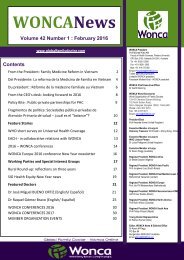Create successful ePaper yourself
Turn your PDF publications into a flip-book with our unique Google optimized e-Paper software.
ASTHMA: ROUTINE CARE• Ensure that a doctor confirms the diagnosis of asthma within 1 month of diagnosis.Assess the patient with asthmaAssess When to assess NoteAsthma symptoms todetermine if asthma iscontrolledEvery visit• Any of the following in the past month indicate uncontrolled asthma:--Daytime cough, difficulty breathing, tight chest or wheezing > twice a week--Nighttime or early morning waking due to asthma symptoms--Limitation of daily activities due to asthma symptoms• Peak flow measurement can be unreliable and need not be used routinely to assess asthma control. Asthma symptoms are more useful.Other symptoms Every visit • Manage symptoms as on symptom pages.• Ask about hayfever: sneezing, itchy or runny nose. Treating hayfever may improve asthma control 13.• Ask the patient using inhaled corticosteroids about a sore mouth 14. See advice below.• Ask about heartburn or upper abdominal pain after eating. Treating gastro-oesophageal reflux may improve asthma control 19.Medication use Every visit • Ensure patient is adherent to treatment before adjusting or adding treatment.• Check that patient can use inhaler and spacer correctly 65.Advise the patient with asthma• Ask about smoking. If yes, urge patient to stop.• Ensure the patient understands the need for medication received:--Beta-agonist (eg salbutamol) inhaler only relieves symptoms and does not control asthma.--Inhaled corticosteroid (eg budesonide) prevents symptoms and controls asthma, but does not give instant relief. It is the mainstay of treatment.• Check that patient can use inhaler and spacer correctly 65.• Inhaled corticosteroids can cause oral thrush: advise patient to rinse and gargle after each dose of inhaled corticosteroid.Treat the patient with asthma• Give inhaled salbutamol 2 puffs as needed up to 4 times a day.• Before adjusting treatment ensure patient is adherent and can use inhaler and spacer correctly 65.• If asthma is uncontrolled:--Start inhaled corticosteroid budesonide 200μg 12 hourly if patient not already on it.--If patient already on inhaled corticosteroid, doctor to double the dose of inhaled corticosteroid budesonide to maximum 400μg 2 puffs 12 hourly.--If still uncontrolled, add slow release theophylline 200mg 12 hourly. Increase to 300mg if still uncontrolled. Stop theophylline if no better after 1 month.• If asthma is controlled:--Continue inhaled corticosteroid at the same dose.--If controlled for at least 6 months, decrease inhaled corticosteroid dose by 200μg.--Stop inhaled corticosteroid if controlled for at least 6 months on 200μg daily.--Inhaled corticosteroids are not needed for the patient with controlled exercise-induced asthma who has had no emergency visits for asthma in the past 6 months.• Oral prednisone is only used for emergency visits for asthma. Refer to doctor if needing more than 2 courses of prednisone in 6 months.Review the controlled patient 3 monthly, the patient whose asthma is uncontrolled after 1 month.Advise patient to return before next appointment if no improvement or worsening of symptoms.66CHRONIC RESPIRATORYDISEASE



